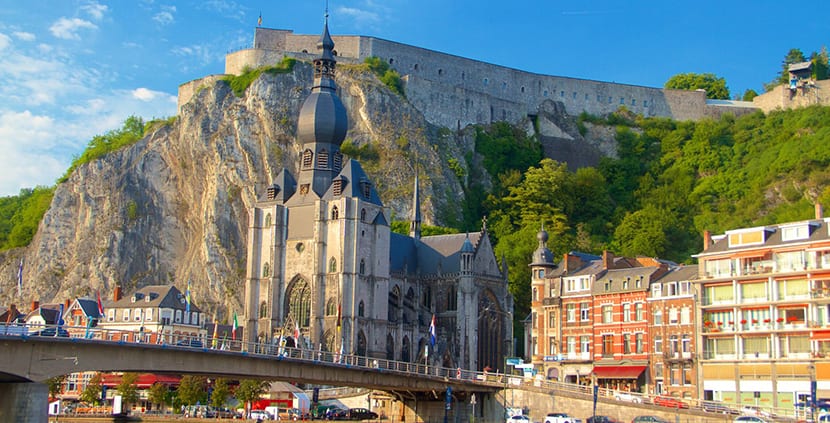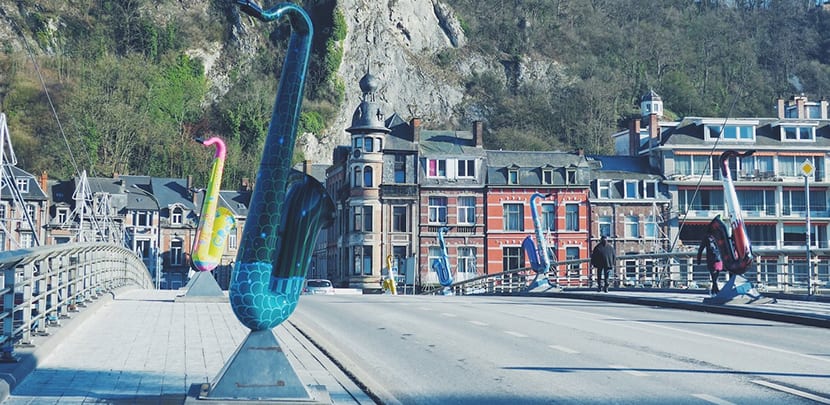
Dinant It is a charming Belgian city that is close to the French border. If this summer you want to walk through charming European corners then Belgium may be your destination and here, Dinant.
Coast on the river, a fantastic cave, perhaps one of the most beautiful in Europe, cradle of the saxophone, a Gothic cathedral, a picturesque citadel overlooking the valley and a great gastronomy concentrate the most important of the tourist offer that Dinant offers. Let's find out all this together.
Dinant, the daughter of the Meuse

It is in the Belgian province of Namur on the banks of the Meuse River, that's why it is called Daughter of the Meuse. Namur is one of the five provinces of Wallonia, Belgium region where three and a half million people live, more than 30% of the national population. Wallonia was created as a result of a regional political movement that wanted the recognition of the particularities of this part of the country and that achieved it in 1970.
But in truth this part of Belgium has thousands of years of history. It was romanized under the hand of Julius Caesar and due to its later handling of iron, time turned its inhabitants into specialists in the iron and steel industry. The new Wallonia dates back to the XNUMXth century and is the protagonist of disputes and divisions of a nationalistic nature that would gain more force in the two world wars. Stability and national unity would only be achieved forty years ago.

Dinant, it's pronounced something like Dyne, it is located about 90 kilometers from Brussels and 30 kilometers from the capital of the province, the city of Namur itself. It rests in a valley with steep rocky sides facing the river and the first inhabitants settled on the coast and then began to move inland, thus creating, over the centuries, a thin city all along the river.
Today Dinant has an island that was created in the XNUMXth century when a branch of the river was filled in. the island is called Île des Batteurs, and it is linked to the city by an embankment. Although the region has an important link with iron, the city itself is a specialist in working with bronze, in addition, it has dedicated itself to agriculture and the extraction of limestone and black marble, for example.
What to visit in Dinant

La Cathedral of Our Lady of Dinant It is a temple of Gothic style of the XNUMXth century It was built to replace an earlier Romanesque church that had collapsed in 1228. Today only the north gate remains of it.
It is a large church that dominates the urban skyline of the city since then and today there are guided tours inside because from inside the colorful stained glass windows can be admired much better. It was repaired and rebuilt several times and of course after the two world wars as well. The visit should start from the outer plaza to observe the Gothic features from outside, its towers and windows, especially the larger bulbous tower which is a XNUMXth century addition.

Inside the baroque shines, in the ceiling, in its columns and in its paintings made by Antoine Wiertz in the XNUMXth century, an artist from the same city. The painting is called We will meet again in heaven and it is a work dedicated to his parents. There are also the colorful stained glass, some of religious tint and others more geometric. In front is the lavishly gilded main altar with a huge cross from which hangs the crucified Jesus.

Do not leave the temple without going through the baptismal font from the XNUMXth century and the pulpit from the XNUMXth century made from a metal produced exclusively in Dinant in the late Middle Ages and called brassware. From the cathedral you are a few steps away from starting to climb to know the citadel and enjoy the fantastic views it offers.
From the citadel you can see the valley and its surroundings. To get there you have to climb 408 steps to the top but if you don't want to walk so much you can take the cableway or if you have a car use it to go up. Either way Entrance is paid to enter the citadel and the ticket costs 8 euros but provides access to the fortress and its corridors. It is not that it is the sea of interesting but since you are there I would not miss it.

The citadel was built in the XNUMXth century to have control of the valley and in the following centuries it was enlarged and rebuilt. In 1703 the French destroyed it and this version of it is later, from the beginning of the XNUMXth century when the Netherlands United Kingdom existed. Together with the citadels of Namur, Liège and Huy it is part of the so-called Citadels of Meuse.
At the beginning I said in Dinant is one of the most beautiful caves in Europe and of course the most beautiful in Belgium. The La Merveilleuse Cave It was discovered in 1904 and is wonderful for the clarity and beauty of its waterfalls and stalactites. The cave is steps from the center, about 10 minutes nothing more, and there are guided tours inside that they take you about 40 meters underground and last one hour. The entrance to the caves costs 9 euros and inside it is cold, on average it is always 13 ºC, so bring a coat.

We also talk about that Dinant is the birthplace of the saxophone And so it is because in Dinant its inventor was born, Adolphe sax, a man who was born and died in the XNUMXth century and was a manufacturer of musical instruments. He was a curious guy who tried instruments and if something did not close him, he perfected them. He was energetic, optimistic and a true inventor who manages to have a major workshop in Paris. There he gives life to the saxophone, among other instruments of the same family.

The saxophone gives a new timbre in the world of music and it does not make it with wood but with copper: it is shaped like a parabolic cone and is played with a reed. Sax manages to patent his invention four years later, in 1846, going through before and after many controversies, envies and disappointments. He died on February 7, 1894 and his grave is in the Montmartre cemetery but the city of Dinant honors him all the time because 28 huge saxophones are distributed, one for each member state of the European Union.
You know then, Dinant is waiting for you.